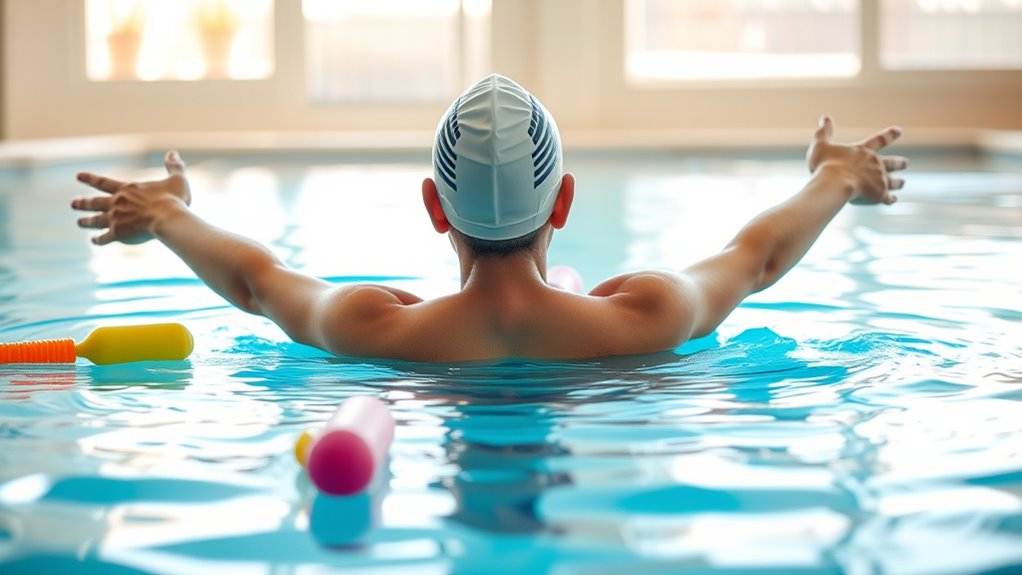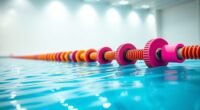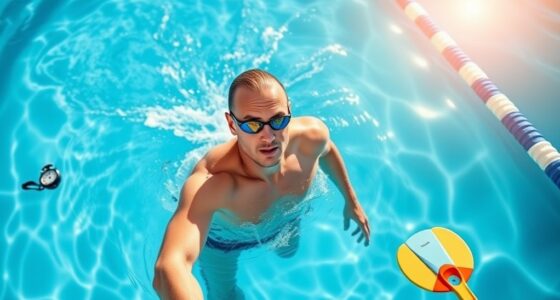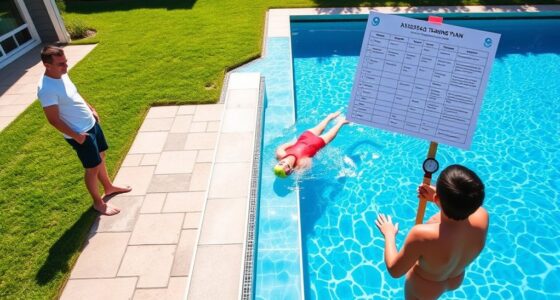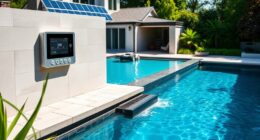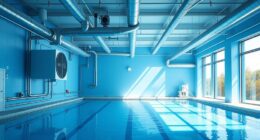To do aquatic therapy at home, set up a safe, level water space with good drainage and lighting, and guarantee easy access. Start with gentle warm-up exercises like stretching and light movements to boost circulation. Incorporate resistance activities such as water walking or leg lifts, combined with balance drills for stability. Finish with relaxing stretches and mindfulness techniques to promote recovery. Keep practicing these routines regularly, and you’ll discover effective ways to enhance mobility and ease pain.
Key Takeaways
- Set up a safe, level aquatic space with proper drainage, lighting, and temperature control to ensure a secure environment for therapy.
- Incorporate gentle warm-up stretches and circulatory exercises in warm water to improve flexibility and blood flow.
- Use resistance exercises like water walking and leg lifts to strengthen muscles and enhance balance safely at home.
- Practice slow, controlled stretching and balance drills in water, followed by relaxation and mindful breathing routines.
- End sessions with calming stretches and deep breathing to promote muscular relaxation, reduce stress, and support recovery.
Setting Up Your At-Home Water Space
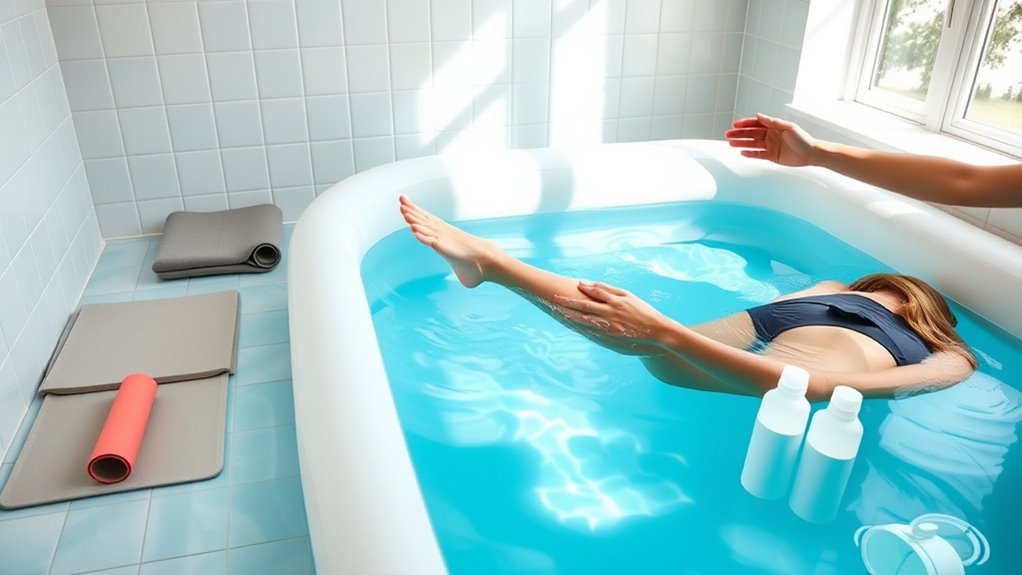
Creating a safe and functional at-home water space begins with choosing the right location. You’ll want a space that’s easily accessible, level, and free of hazards. If you’re using a portable pool or tub, verify it fits comfortably in your designated area and can be filled and drained easily. For permanent setups, consider installing a dedicated area with sturdy flooring and good drainage. Make sure the space has ample room for movement and safe entry and exit points. Lighting is also important to prevent slips or accidents. Keep the area clear of obstacles and sharp objects, and ascertain the water source is reliable. Proper planning now will help you create a secure environment for effective and enjoyable aquatic therapy.
Warm-Up Exercises for Flexibility and Circulation
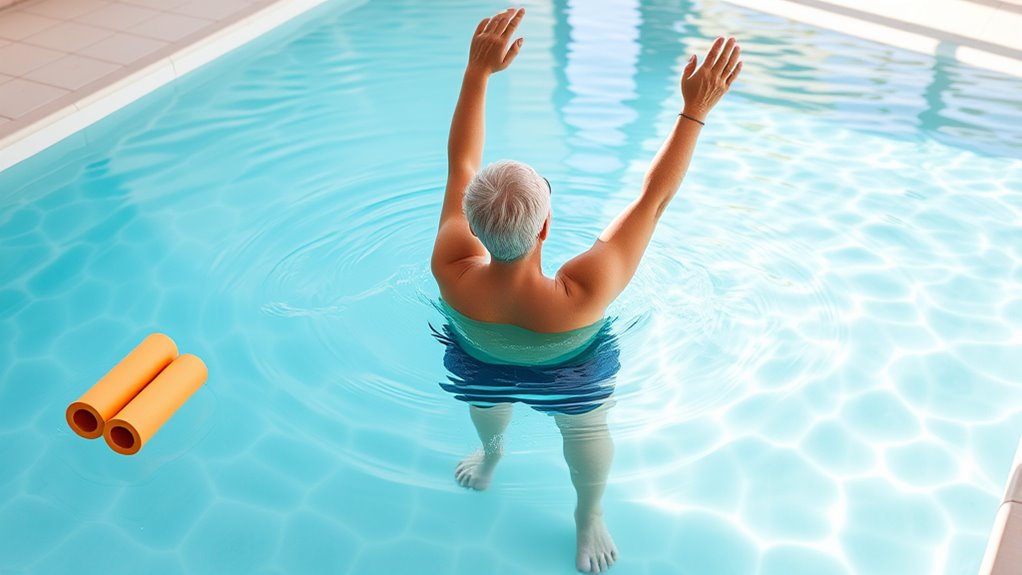
Starting your warm-up with gentle stretching techniques can improve your flexibility and prepare your muscles for activity. Warm water helps boost circulatory flow, making these exercises more effective and comfortable. Additionally, incorporating insulation upgrades can help maintain optimal water temperature during your sessions, enhancing comfort and efficiency. By focusing on these points, you’ll set a solid foundation for a safe and beneficial aquatic therapy session.
Gentle Stretching Techniques
To prepare your muscles and joints for aquatic therapy, gentle stretching techniques are essential. These stretches improve flexibility and help prevent injury during your session. Start with slow neck rolls, gently turning your head side to side. Move on to shoulder circles, lifting your shoulders toward your ears then rolling them back. Stretch your arms by reaching overhead and softly pulling your wrist or elbow. Focus on your legs with gentle hamstring and calf stretches, either standing or seated. Keep movements smooth and controlled, avoiding any pain or discomfort. Breathe deeply as you stretch, holding each position for about 15-20 seconds. These simple exercises loosen tight muscles and increase circulation, setting a calm, prepared state for your aquatic therapy. Incorporating proper color accuracy calibration can further enhance your visual environment and comfort during post-therapy relaxation.
Boost Circulatory Flow
Have you ever noticed how a quick movement can get your blood flowing and energize your body? Boosting circulatory flow is essential before your aquatic exercises. Start with light arm circles, moving your arms forward and backward to stimulate blood movement in your upper body. Follow with ankle rotations—lift your feet slightly and rotate your ankles in circles to improve circulation in your legs. Gentle knee lifts also help activate blood flow to your lower limbs. These simple warm-up moves prepare your muscles and enhance circulation, reducing the risk of stiffness or injury. Keep the movements slow and controlled, focusing on the sensation of increased blood flow. Incorporating circulatory benefits into your routine can further optimize your warm-up process. Doing these exercises before your main routine helps your body warm up, making your aquatic session more effective and comfortable.
Warm Water Benefits
Immersing yourself in warm water can considerably enhance your flexibility and circulation during warm-up exercises. The warmth relaxes your muscles, making them more receptive to movement and stretching. As your muscles loosen, you’ll find it easier to perform gentle stretches that improve joint mobility. Increased blood flow from the warm water also boosts circulation, delivering oxygen and nutrients more efficiently to your tissues. This combination reduces stiffness and prepares your body for more active movements, lowering the risk of injury. The soothing temperature helps ease muscle tension and discomfort, making warm-up routines more comfortable and effective. Incorporating warm water into your warm-up not only enhances flexibility but also promotes circulation, setting a solid foundation for your aquatic therapy session. Additionally, creating a comfortable environment can further support your relaxation and effectiveness during warm-up routines.
Strengthening Movements to Improve Mobility
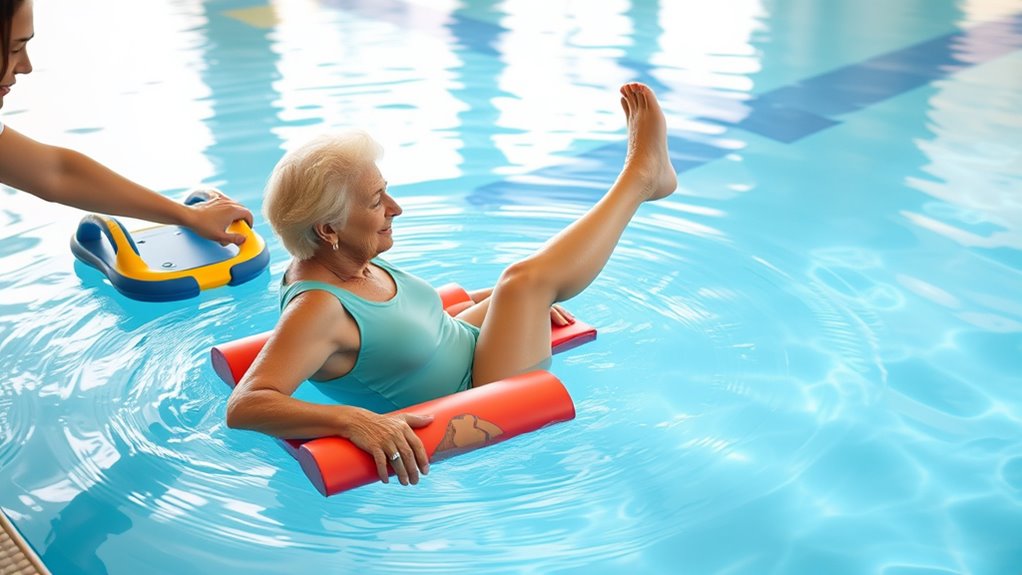
Strengthening movements are essential for enhancing mobility and maintaining independence, especially when practicing aquatic therapy at home. Water provides resistance that makes these exercises effective and gentle on your joints. Focus on movements that target major muscle groups to support your posture and balance. To get started, try:
Water-based strengthening exercises are key for mobility, balance, and maintaining independence at home.
- Leg lifts while holding onto the pool edge
- Water walking or jogging to boost leg strength
- Arm circles to improve shoulder mobility
- Standing knee bends for thigh and hip strength
Perform these exercises consistently, aiming for 10-15 repetitions each. The water’s resistance challenges your muscles without risking injury. Incorporating aquatic exercises can further enhance the benefits of your routine. Regular practice helps you stay active and promotes better overall mobility.
Gentle Stretching to Reduce Stiffness and Pain

Gentle stretching is an essential component of aquatic therapy, especially for reducing stiffness and alleviating pain. Water’s buoyancy supports your body, making stretches easier and safer. Begin with simple movements like reaching your arms overhead or gently bending your knees in the water. Focus on slow, controlled movements, holding each stretch for about 15-30 seconds. Breathing deeply helps relax tense muscles and enhances flexibility. Avoid forcing your body into uncomfortable positions; instead, listen to your sensations and adjust as needed. Incorporate stretches targeting areas prone to stiffness, such as your back, hips, and shoulders. Regular gentle stretching can improve your range of motion, reduce discomfort, and promote relaxation. Following safe stretching practices can help prevent injury and maximize benefits. Consistency is key—practice these stretches a few times a week for ideal results.
Balance and Stability Drills for Better Posture
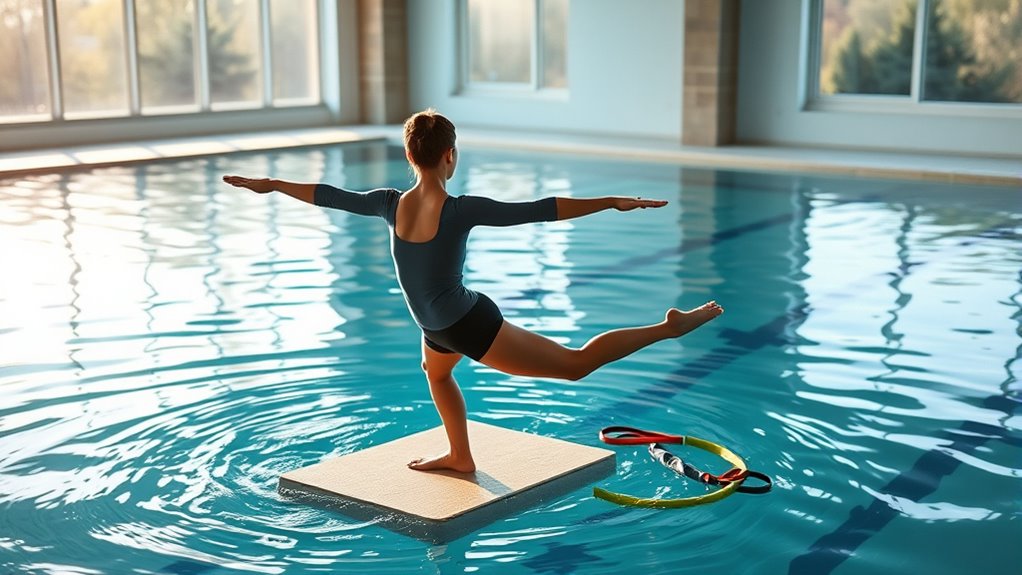
To improve your posture and enhance overall balance, incorporating specific stability drills into your aquatic routine can be highly effective. These exercises strengthen your core, improve coordination, and promote better alignment. Start by standing near the pool wall for support. Engage in gentle leg lifts, focusing on maintaining a steady posture. Practice single-leg stands, shifting your weight slowly to challenge your stability. Incorporate arm movements while standing to activate your core muscles. Finally, try slow, controlled torso twists to enhance rotational stability.
Enhance balance with gentle aquatic stability drills: core strengthening, slow movements, and pool support for better posture.
- Maintain a tall, aligned posture during all exercises
- Focus on slow, deliberate movements to maximize engagement
- Use pool supports if needed to prevent falls
- Breathe steadily to maintain control and focus
Cooling Down and Relaxation Techniques
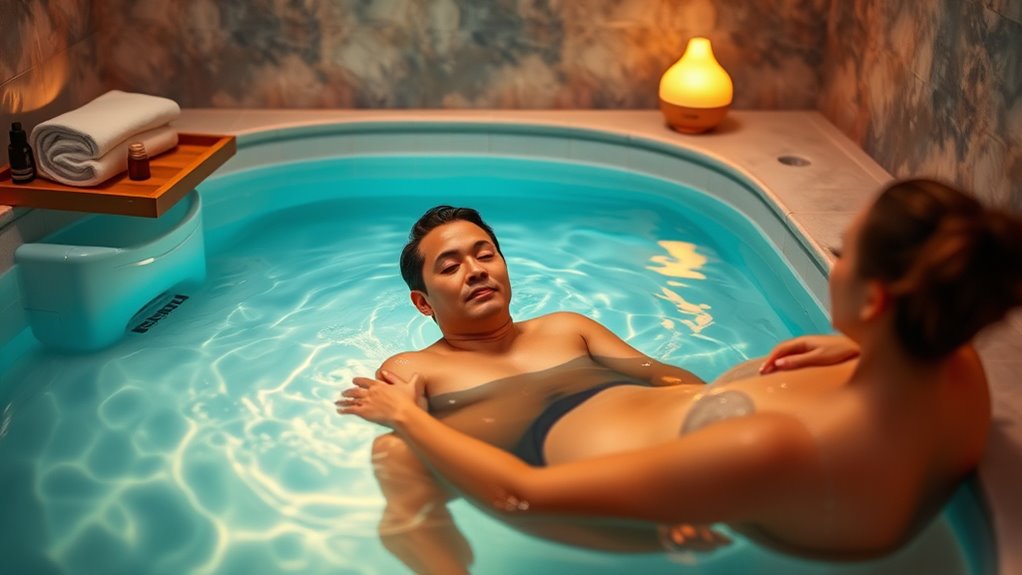
After your aquatic session, take a few moments to incorporate gentle stretching exercises to release tension. Focus on deep breathing and mindfulness to calm your mind and body. Finish with relaxation postures to help your muscles recover and foster a sense of tranquility. Incorporating mindful movement can enhance your overall sense of well-being and deepen your connection with your body.
Gentle Stretching Exercises
Cooling down after aquatic therapy is essential to prevent muscle soreness and promote relaxation. Gentle stretching helps elongate muscles, improve flexibility, and ease tension. Focus on slow, controlled movements, holding each stretch for 15-30 seconds. You can stretch your arms overhead, gently twist your torso, or stretch your legs while seated in the water. Incorporate performance upgrades into your routine to enhance muscle recovery and overall mobility. Consider incorporating these simple routines:
- Arm and shoulder stretches to release tension
- Gentle leg stretches to improve mobility
- Neck stretches to reduce stiffness
- Trunk twists for spinal flexibility
Always breathe deeply and avoid bouncing or forcing your muscles. These gentle stretches can enhance your recovery, ease discomfort, and prepare your body for daily activities. Keep movements smooth, and listen to your body’s signals.
Breathing and Mindfulness
Have you ever noticed how focused breathing can deepen your sense of relaxation after aquatic therapy? When you slow down your breath, you activate your parasympathetic nervous system, helping your body calm down. Try inhaling deeply through your nose for a count of four, holding for a moment, then exhaling slowly through your mouth for a count of six. Focus on your breath, letting any tension melt away. Incorporate mindfulness by paying attention to sensations in your body or the sounds around you. This practice not only promotes relaxation but also enhances your overall sense of well-being. Regularly practicing breathing and mindfulness techniques after your aquatic sessions can improve your mental clarity and reduce stress, making recovery more effective. Additionally, understanding the benefits of mindfulness can motivate you to stay consistent with these calming routines.
Relaxation Postures
Incorporating relaxation postures into your aquatic therapy routine can considerably enhance your sense of calm and recovery. These postures help your body relax after movement, reducing tension and promoting healing. To maximize benefits, try these techniques:
- Floating on your back with arms relaxed at your sides to release shoulder tension.
- Gentle side-lying positions to stretch your spine and hips comfortably.
- Seated leaning forward or backward against the pool wall for gentle back and neck relief.
- Deep breathing while floating to deepen relaxation and oxygenate your muscles.
Hold each posture for several minutes, focusing on slow, deep breaths. These routines calm your nervous system, ease muscle soreness, and prepare your body for the next session or daily activities.
Frequently Asked Questions
What Equipment Is Essential for Effective At-Home Aquatic Therapy?
You’ll need a few key pieces of equipment for effective at-home aquatic therapy. A sturdy, above-ground pool or a large, portable tub is essential. You should also have waterproof resistance bands, floating devices like noodles or kickboards, and non-slip mats for safety. Additionally, waterproof gloves and shoes can help with grip and comfort. With these, you can create a safe, versatile environment to improve mobility and ease pain.
How Often Should I Perform These Water Exercises Weekly?
Research shows that exercising just two to three times a week can substantially improve mobility and reduce pain. You should aim to perform your water exercises about three times weekly for ideal results. Consistency is key, so try to stick to a routine that fits your schedule. By doing so, you’ll maximize benefits like increased strength, flexibility, and pain relief, all while minimizing the risk of injury.
Can Aquatic Therapy Replace Clinical Treatments Completely?
Aquatic therapy can’t fully replace clinical treatments since it works best alongside medical care. While water exercises can improve mobility and reduce pain, they don’t address underlying health issues or provide thorough diagnostics. You should continue with your healthcare provider’s recommendations and use aquatic therapy as a complementary approach. Always consult your doctor before making any changes to your treatment plan to ensure safety and effectiveness.
Are There Safety Concerns for Elderly or Disabled Individuals?
Safety is a key concern when you’re considering aquatic therapy at home, especially for elderly or disabled individuals. Like steering a boat through unpredictable waters, you need proper supervision, stable equipment, and clear instructions to avoid accidents. Always consult healthcare professionals first, make certain the pool area is secure, and start slowly. With these precautions, you can enjoy the benefits while keeping safety afloat.
How Can I Track Progress and Improvements Over Time?
You can track your progress by keeping a daily journal of your mobility and pain levels, noting any improvements or setbacks. Take regular measurements, like how far you can walk or stretch, and record these consistently. Use photos or videos to visually document your progress over time. Additionally, consult with your healthcare provider periodically to assess your improvements and adjust your routines accordingly for ideal results.
Conclusion
Practicing aquatic therapy at home can profoundly boost your mobility and ease pain. Did you know that just 30 minutes of water-based exercise can reduce joint stiffness by up to 40%? By creating a simple water routine, you’re taking control of your health and making movement enjoyable again. Stay consistent, listen to your body, and watch as your strength and flexibility improve over time. Your at-home water therapy journey can truly transform your well-being.
